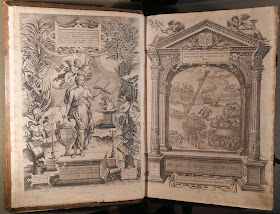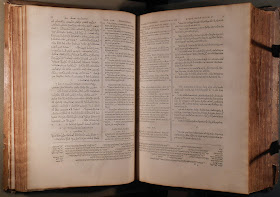 Printer Christophe Plantin was a Protestant sympathizer during the height of the Reformation--but his greatest legacy is a Catholic masterpiece. In Catholic-ruled Antwerp, his sympathies drew the suspicions and threats of the authorities, so Plantin decided to undertake a massive printing project in order to publicly prove his loyalties, both to the Church and the Catholic king, Philip II of Spain. He proposed a comprehensive polyglot Bible that would present all of the canonical texts and the Catholic apocrypha in Hebrew, Greek, Latin, and the Chaldean languages--Syriac and Aramaic. Philip II gave his enthusiastic support to the project, but not his financial backing; instead, he sent the renowned theological Benito Arias Montano to oversee the theological and linguistic correctness of the text.
Printer Christophe Plantin was a Protestant sympathizer during the height of the Reformation--but his greatest legacy is a Catholic masterpiece. In Catholic-ruled Antwerp, his sympathies drew the suspicions and threats of the authorities, so Plantin decided to undertake a massive printing project in order to publicly prove his loyalties, both to the Church and the Catholic king, Philip II of Spain. He proposed a comprehensive polyglot Bible that would present all of the canonical texts and the Catholic apocrypha in Hebrew, Greek, Latin, and the Chaldean languages--Syriac and Aramaic. Philip II gave his enthusiastic support to the project, but not his financial backing; instead, he sent the renowned theological Benito Arias Montano to oversee the theological and linguistic correctness of the text. The project, which lasted from 1568-1573, nearly bankrupted Plantin. He employed nearly 40 printers to complete it, and many of the original 1200 copies were lost in a shipwreck in 1572. However, it did win him the favor of Philip II, who granted Plantin the exclusive right to print Roman Catholic liturgical books in his domain--along with the dubious honor of overseeing the skill and theological accuracy of other printers. Despite its complicated origin story, the Polyglot is Plantin’s masterpiece. Today, it remains incredibly important for its contributions to the study of language, theology, Biblical history, and the art of printing.
The project, which lasted from 1568-1573, nearly bankrupted Plantin. He employed nearly 40 printers to complete it, and many of the original 1200 copies were lost in a shipwreck in 1572. However, it did win him the favor of Philip II, who granted Plantin the exclusive right to print Roman Catholic liturgical books in his domain--along with the dubious honor of overseeing the skill and theological accuracy of other printers. Despite its complicated origin story, the Polyglot is Plantin’s masterpiece. Today, it remains incredibly important for its contributions to the study of language, theology, Biblical history, and the art of printing.Rauner owns five volumes of the original eight-volume folio. The first four comprise the Old Testament, with the original Hebrew text and Latin translations on the left page, and a Greek translation with Latin commentary on the right. At the bottom of the left page is the Aramaic text, which is paraphrased in Latin on the opposite page. The fifth volume contains the complete New Testament, with a Syriac translation and Latin commentary on the left page, the original Greek text with a Latin translation on the right, and a translation of Syriac into Hebrew with paraphrased Latin at the bottom. This volume also includes a Latin-Syriac index of phrases.
If you want to check out this incredibly complex feat of printing--or use your high school Latin skills to learn some ancient languages--come to Rauner and ask for Rare Book BS1 1569, volumes 1-5.
Posted for Emily C. Estelle '15

No comments:
Post a Comment